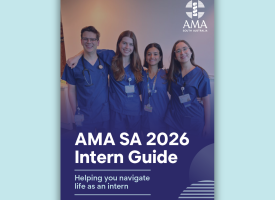Action needed to tackle health misinformation on internet, social media
AMA Position Statement on Health Literacy
The Australian Government must invest in long-term, robust online advertising to counter health misinformation on the internet, including on social media channels, the AMA said today.

Releasing the AMA Position Statement on Health Literacy, AMA President Dr Omar Khorshid said the plethora of information online about health and wellbeing is confusing for many people, who have difficulty determining which sources of information are reliable.
“Health literacy is critical to people making informed choices about their health and health care and living longer, healthier lives,” Dr Khorshid said.
“Many groups in our community already have lower levels of health literacy – people with lower levels of education, from cultural and linguistically diverse backgrounds, people who are unemployed, people with disability, and people with lower socio-economic status.
“Traditionally, people have learnt about healthy choices from their families, schools, doctors, and government advertising campaigns.
“However, people are increasingly seeking information from websites and social media.
“Making reliable health information easily available online has positive effects on people’s health literacy.
“A study by St Vincent’s Hospital in Melbourne found that 77 per cent of patients who searched for their symptoms online before attending the hospital, as they found it easier to communicate with and understand doctors and nurses and were able to ask more informed questions.
“But the internet has the potential to significantly magnify health misinformation campaigns, as people can easily absorb misinformation delivered directly to them through advertising, celebrity influencers, and people in positions of power.
“We have seen this with the anti-vaccination movement, and the countless conspiracy theories about the COVID-19 pandemic that circulate constantly on the internet.
“The Australian Competition and Consumer Commission (ACCC) does its best to crack down on fraudulent claims about items of clothing or glorified lava lamps being able to repel COVID-19, but more action is needed.
“We need an Australian Government-funded campaign to counter this misinformation and promote healthy choices, including information about vaccine safety and the health risks associated with alcohol, junk food, tobacco, and other drugs.
“Social media companies must also acknowledge their responsibility and work actively to counter health misinformation on their platforms.”
The AMA is also calling on all State and Territory Governments to collaborate with the Australian Government to extend the current Health Direct website to provide a single, accessible, national source of verified health information. The Victorian and Queensland Governments currently do not contribute any funding to Health Direct.
The AMA Position Statement on Health Literacy is available here.
Background
- Health literacy is “the degree to which individuals can obtain, process and understand the health information and services they need to make appropriate health decisions.
- Low levels of health literacy are associated with other measures of social and economic disadvantage, and efforts to improve health literacy must respond appropriately to the varying needs of diverse population groups.
- People with lower levels of educational attainment tend to have poorer health literacy, while highly educated individuals find it easier to navigate the healthcare system.
- Health literacy levels tend to be lower in Australians from culturally and linguistically diverse backgrounds.
- Other characteristics that have been associated with lower levels of health literacy include being unemployed, having a disability, and having a lower socio-economic status.
- People with low health literacy are more likely to be hospitalised and have higher healthcare costs. In Australia, the cost of low health literacy is estimated at between 3 per cent and 5 per cent of health system costs.
*Sources: Australian Bureau of Statistics, Australian Commission on Safety and Quality in Health Care



